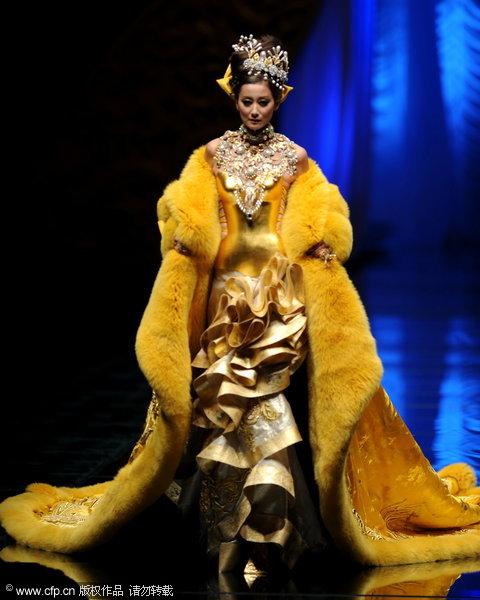East meets West on fashion week
 |
|
Guo Pei's Thousand and Two Nights collection. [CFP] |
"Yunnan produces a poisonous mushroom," he said. "If you eat it raw, you'll have this illusion and see lots of wonderful images like fairies. The fairies can be cool and enchanting. But in my mind, the evil spirits are also always beautiful and luxurious. It's no exception this time. And the sense of design is given prominence as well."
As in his previous collections, Chinese elements were infused in six themes that included ink painting, green lights, "message of the flower," sheer beauty, blue lotus and snake leather prints that conjured up an Imaginary Land on the runway.
NE Tiger's Butterfly and Fan-Good Karma collection on November 2 drew heavily on traditional embroidery techniques combined with modern flairs. The old and new combo is expected by many Chinese fashionistas to be a common thread through the season.
"This year, we featured the butterfly and the fan as the theme and inspiration of our haute couture collection," explained NE Tiger Chief Exectutive Zhang Zhifeng. "We used the fan for the launch of our first men's collection this year because traditionally the fan has been regarded as the symbol of male authority and courtesy in ancient China. And similarly, butterfly represents the romantic and lively quality of Chinese females."
The symbols were exemplified as the delicate embroidery that ran from the outfits to the stage design and video effects of the show.
"You'll see the stair on the catwalk designed in the shape of a fan and the video backdrop that features a butterfly designed by the creative minds of the Beijing Olympics," added Zhang. "In addition, the original music that accompanied the show drew inspiration from an ancient Chinese musical score which I came across accidentally in Taipei's Palace Museum. All of these elements add to ambience of the show."
Abandoning the common Chinese elements of patterns and materials, Zhao Huizhou drew inspiration for her Eachway collection from three low-profi le colors: black, white and gray because "they represent the withdrawn character of Chinese people." She added that her focus on clothes' material, structure and details barred her from using more complicated but "useless" colors.
Zhao's next season's trends are a "return to classics" that combined different traditional fashion elements. She explained that the financial crisis had brought too much pressure on people, so her 2010 spring/summer wear collection is all about being peaceful and confident. "Nothing too complicated, just simple classical black, white and gray."
Apart from the constant crisscross between Chinese elements and international styles, fashion week featured a record seven men's wear shows, including ecofriendly themed VLOV collection by Wu Qingqing and the comparatively more masculine Hong Jinshan show. Even brands like NE Tiger and Mi Huang Cashmere by Qi Gang, which had been dominated by women's wear introduced the Y chromosome to their shows. Fujian-based brand Cabbeen was one men's wear highlight. Using the theme "Urban Dreamers," designer Yang Ziming boldly adopted fruity green and rosy pink to the show's three chapters: Cabbeen Lifestyle, Cabbeen Urban and Cabbeen Chic.
"These colors should fill the spring of a young urban man," explained Yang.
According to Yang, "well-fitting and comfortable" are the key words for next season's men's wear, and seen in his short jackets, thin half-casual suits and tight knit pullovers. "Fashion should be more graceful and convenient. To know what your customers need is the ultimate goal for a designer," said Yang.
Wang Qing, president of China Fashion Association, credited the increase in men's fashions to a rising attention to male consumers. "Chinese men now have more verified and specific requirements for clothes. The market calls for more men's wear designers and brands."
The China Fashion Week Spring/Summer 2010 also featured the first "Taiwan Fashion Day" in its 12-year history. A dozen Taiwanese fashion brands and designers exhibited their works on Saturday that also drew from Chinese history and culture.
"The 5,000-year old culture is our shared historical background," said Taiwanese designer Tsai Meiyue who devoted her entire show to Chinese elements. She used the Chinese royal colors of gold and red instead of traditional white for her wedding gowns, along with the generous use of Suzhou-styled embroideries.
 0
0 







Comments